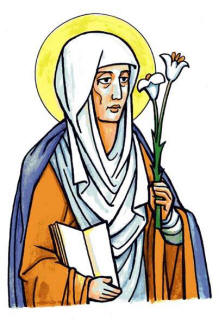Adela Adelaide Saint
Saint Adela
Etymology: From the Germanic: "Of noble lineage."
Adela, Adelaide, Alicia
Adela
Queen, widow. 1062-1137.
Youngest daughter of William the Conqueror. She married Stephen of Blois. She played a role in political affairs and was generous to
Benedictine abbeys and churches.
Adelaide of Bellich, OSB, Abbess
Also known as Alicia
+c. 1015.
Daughter of Megengose, Count of Guelder, she was abbess of Villich (Bellich, Willich) on the Rhine River near Bonn, and later of Our Lady of
the Capitol, Cologne. Adelaide required her nuns to study Latin in order to pray the office. Known for her prudence and generosity to the
poor.
Adelaide of La Cambre, OSB, Cist.
Also known as Alicia
+1250; cult confirmed in 1907.
She was a young Cistercian nun from the La Cambre convent. She suffered many physical afflictions, becoming blind, leprous, and later
paralyzed, which led to her segregation from the community. Adelaide offered her suffering for the souls in purgatory and had visions of
their liberation through her intercession.
Saint Adelaide of Pfalzel, OSB. Queen, widow, and abbess
Also called: Adelaide, Alicia
+c. 730
Founder of the Pfalzel convent (Palatiolum) in Trier, Germany. She was the daughter of Saint Dagobert II, King of the Franks, and the sister
of Saint Irmina. She entered religious life after her husband's death and was a disciple of Saint Boniface.
Saint Adela

Etymology: From the Germanic: "Of noble lineage."
Born in Burgundy, France c. 931.
+December 16, 999, at the monastery of Selta (Seltz).
Daughter of King Rudolph II of Burgundy, who died when she was six years old. She was promised in marriage at the age of two as part of a
treaty between Rudolph and Hugo of Provence. She married Lothair at 16, who later became King of Italy. Her daughter Emma became Queen of
France.
Her husband died young, possibly poisoned. Adela became a widow at 19 in 950. Her daughter Emma was still a child. The usurper Berengar sought to marry her to his son to consolidate his power. When Adela refused, he imprisoned her, stripping her of all her powers and titles.
Her chaplain, Father Martin, was amazed because Adela did not complain and treated the jailers kindly. She accepted everything as coming from the hands of God for her good. Stripped of her royal garments and jewels, she was given rags to wear. She spent several months in prison, dedicated to prayer. The jailers exclaimed: "How much heroism this queen has! She does not scream, does not despair, does not insult. She only prays and smiles amid her tears!"
She was rescued by German King Otto the Great, who defeated Berengar. Otto fell in love with Adela, and they married in 951. The following year, Otto was crowned emperor in Rome by Pope John XII. As empress, she dedicated herself to helping the poor, building temples, and assisting missionaries, religious, and preachers. She was widowed in 973 and was mistreated by her stepson, Emperor Otto II, influenced by his wife Theophano from Constantinople, who was very dominant. Adela sought help from Saint Mayolus, Abbot of Cluny, who spoke in such a way to Otto that he was convinced that no one could advise and accompany him better than his holy mother. The emperor called Adela again, apologized, and welcomed her back to the imperial palace.
When Otto II died in 983 during a war, and Otto III was very young, Theophano took authority as regent and treated Adela harshly. She said, "Only in religion can I find comfort for so many losses and misfortunes." In the midst of her grief, she found strength and peace in prayer. She responded to those who mistreated her with kindness and meekness. Theophano died sick in 991, and Adela returned to the court as regent. She used her power to evangelize and help the poor. She built and restored monasteries and churches.
She was a kind mother to her subjects. She bore no resentment toward anyone. She ruled Germany with kindness and compassion, earning the
love of the people.
She founded several monasteries of religious and was concerned with the evangelization of those who still did not know the Catholic faith.
She worked hard to reconcile those who were in conflict.
Saint Adela had great spiritual directors, including several saints: Saint Adalbert, Saint Mayolus, and Saint Odilon. The latter wrote: "The life of this queen is a marvel of grace and goodness."
When Otto III took the kingdom, Adela retired to the convent of Selta near Cologne. Although she never entered religious life, she spent the rest of her days in prayer.
She died on December 16, 999. Although ingratitudes and persecutions caused her much suffering throughout her life, by the time of her death, she had earned the esteem and love of her entire nation.
Canonized in 1097 by Pope Urban II.
Patroness of victims of abuse, brides, empresses, exiles, prisoners, second marriages, and widows...



.jpg)









.jpg)





.jpeg)





.jpeg)



.jpeg)








.jpeg)



.jpeg)

.jpeg)

.jpeg)

.jpeg)




.jpeg)
.jpg)

.jpeg)






.jpeg)
.jpeg)




.jpeg)





.jpeg)


.jpeg)

.jpeg)

.jpeg)

.jpeg)







.jpeg)
.jpeg)
.jpeg)





.jpeg)



.jpeg)






.jpg)
.jpeg)









.jpg)


ulva-Logo.jpg)




.jpeg)



.png)















.png)























